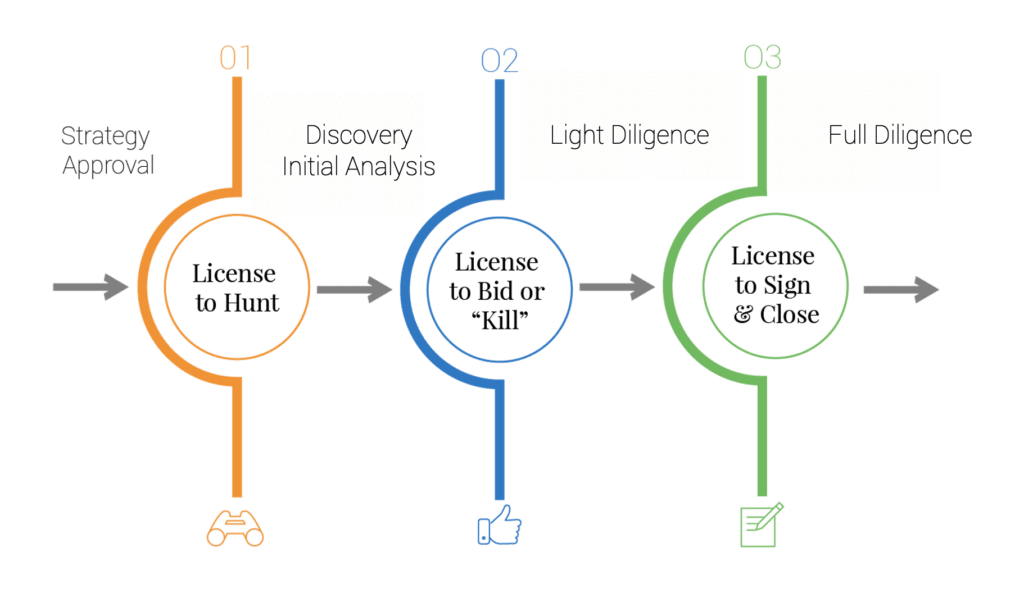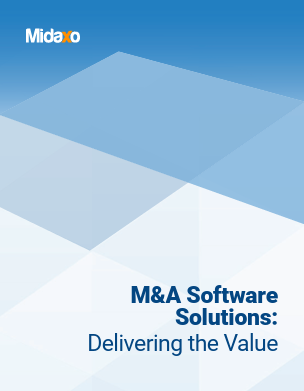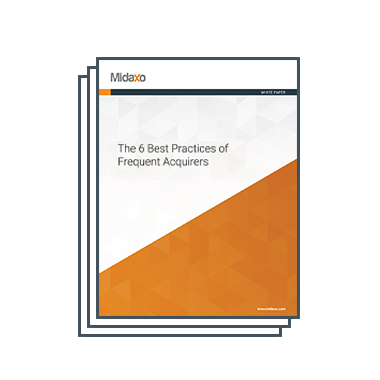Managing an M&A pipeline befitting of today’s deal environment is increasingly becoming a juggling act of speed – while at the same time, requiring active management of vast amounts of information. Taking the time to structure the M&A pipeline process and the pattern of workflow in the evaluation of targets will allow for more informed and timely decisions to be made and ultimately, provide a higher chance of the most suitable targets being pursued to acquisition.
See how Daimler AG actively manages its worldwide M&A pipeline with Midaxo
The critical steps of the M&A pipeline process can be broken down into four clear stages – Discovery, Initial Analysis, Light Diligence and Full Diligence.
- Discovery – This stage focuses on researching potential targets and filtering out unsuitable candidates based on specific acquisition criteria. This stage is typically based on the review of publicly available data and is assumed to be pre-NDA.
- Initial Analysis – This stage should be focused on collecting further discovery facts on potential targets considered as suitable to move from Discovery to Initial Analysis. This stage of deal origination is typically undertaken as a desk study – based on publicly available data and is assumed to be pre-NDA.
- Light Diligence – The work undertaken in the Discovery and Initial Analysis stages will provide the foundations for a more detailed review of potential targets across a Light Diligence exercise. It’s assumed that an NDA will be in place with a potential target before Light Diligence commencing. This stage involves a target supplying a limited amount of confidential information. Preliminary site visits can also be conducted during this stage.
- Full Diligence – Full Diligence should only be conducted on potential targets that stand a good chance of being acquired (given the time and costs associated with a due diligence exercise). While the scope of Full Diligence will differ across all deals, this stage typically covers further site visits and interviews, additional information collection and detailed analysis thereof. Consideration should also be given to the feasibility of closing the deal and initial integration planning.
The Importance of Stage-gates When Evaluating Targets
As with other areas of the M&A process, the approach to pipeline management should be made systematic and repeatable – where possible – but also allow for a degree of flexibility. As a start, any organization pursuing M&A should implement a well-defined Stage-gate Approval Process (i.e. clear decision points) to drive effective decision-making across the various stages of deal origination.
Many organizations have poorly managed Stage-Gate processes (or none at all) – leading to, for example:
- Altogether lost opportunities with potentially well-fitting targets;
- Losing out on targets later in the M&A pipeline process due to the inability to make timely decisions (i.e. working reactively rather than proactively);
- Acquiring the wrong/poor-fit targets as a result of a weak evaluation process and lack of deal-governance.
A well-functioning Stage-Gate Approval Process can be viewed as a three-tiered approach – with the four stages of the M&A pipeline process (Discovery > Initial Analysis > Light Diligence > Full Diligence) sitting within these gates.

1. License to Hunt
Relevant Stages: Discovery & Initial Analysis
A License to Hunt can be thought of as alignment between key members of an organization – such as the M&A/Corporate Development department, business unit leads, CFO, CEO, etc. Agreement should centre around (i) whether M&A is a suitable course of action (or whether an organic growth path should be pursued) and (ii) how exactly an M&A program should be designed to best support overall strategic objectives.
Following the granting of a “License to Hunt”, an initial evaluation of targets from an “outside-in” perspective should be carried out to establish whether they could contribute to an organization’s the overall strategy.
The target selection & evaluation process should answer (at a minimum) the same fundamental questions every time – such as (i) will the target add value to the organization (ii) does the target fill a product/service or geographical gap (iii) does the target expand capabilities or create opportunities? (iv) does buying make more sense than building?
Evaluative points and what’s considered important will, of course, differ across organizations. The critical thing to note here is that an organization should approach the fundamentals of target evaluation in the same way each time. This becomes more important as the number of targets evaluated increases. By way of example, think of the Model T (the world’s first mass-produced car) – the production line for the Model T was centred around achieving efficiency and a high output volume. In looking for a way to increase the efficiency of production, Henry Ford implemented a systematic and repeatable production line – therefore significantly reducing the time and costs involved in making a car while increasing output. The same principle of systemization can – and should – be applied to target evaluation.
The easiest way to approach implementing a systematic and repeatable approach to target evaluation is to begin by defining the evaluation criteria to be applied to all potential targets/deals – examples include:
- Strategic Fit – e.g. how critical is the opportunity towards helping the acquiring organization achieve its purpose, vision and goals;
- Market Health – e.g. assess how healthy the country in which the target is based is from an economic perspective. Consider evaluating the market opportunity size, unemployment and GDP growth rates (historic, actual & forecast) and other macro indicators, etc.;
- Market Stability – e.g. this will include ease of doing business, political stability, corruption, the rule of law and acceptability of foreign direct investment, etc.;
- Regulation Constraints/Considerations – e.g. consider the implications of entering a market where regulation changes frequently or where regulation is heavy;
- Competition – e.g. consider the degree of market concentration, opportunities for roll-up and key consolidators;
- Financial Strength & Performance – e.g. consider revenue, EBITDA, cash flow, debt management, cost structures, cash flow and prior investment rounds into the target;
- Operational Strength & Performance – e.g. assess whether the management team is reliable or whether it needs replacing. Additionally, consider employee turnover and skills/capability gaps, etc.;
- Deal Feasibility – e.g. consider alignment of the Board of Directors and whether the target works closely with existing active investors (which could prove problematic).
2. License to Bid or Kill
Relevant Stages: Light Diligence
A License to Bid can be viewed as the approval to submit a Term Sheet or Letter of Intent (LOI) and proceed to Full Diligence if a target successfully passes through the Discovery, Initial Analysis and Light Diligence Stages of the M&A pipeline process. Alternatively, the M&A team has a License to Kill a target if it’s considered a poor fit upon further analysis.
The purpose of Light Diligence is to:
- Reaffirm the conclusion made as part of the Discovery and Initial Analysis phases (i.e. that the target provides a good fit and should be pursued – via reference to more in-depth strategic, financial, commercial, and operational considerations, etc.);
- To assist with indicative valuation/pricing decisions;
- To identify any challenging integration issues. As part of initial integration considerations, thought should be given to the operations of a target, how they align/complement the existing operations of the acquiring organization, what synergies are available (cost and/or revenue) and the magnitude of the integration project that would have to be undertaken.
3. License to Sign & Close
Relevant Stages: Full Diligence
Successful completion and sign-off of the Full Diligence stage is a pre-requisite to the granting of a License to Sign & Close. Whether an M&A team is granted a License to Sign & Close (i.e. the target is considered a “go”) will ultimately depend on the key decision-makers within an organization (likely to be the Board of Directors/Shareholders/M&A Steering Committee).
Key decision-makers can be more objective than the core M&A team given they will not have been subject to the finer details of the earlier evaluation stages of Discovery > Initial Analysis > Light Diligence > Full Diligence. This provides the advantage of minimizing deal-fever taking over and helps address high-level matters such as:
- Desirability – what synergies are on offer?
- Feasibility – can the deal be closed?
- Validity – compare valuation to expected future performance and anticipated synergies and question “does this look reasonable?”
Takeaway
- The M&A pipeline process should be broken down into clear evaluation stages – for example, Discovery > Initial Analysis > Light Diligence > Full Diligence.
- The M&A pipeline stages should sit within clearly defined stage-gates – for example, License to Hunt, License to Bid or Kill, License to Sign & Close.
- A target should not pass through a stage-gate to the next stage of evaluation until specific criteria are met.
- Taking the time to structure the M&A pipeline process will provide a higher chance of the most suitable targets being acquired and help avoid the likelihood of the wrong deals being pursued.





